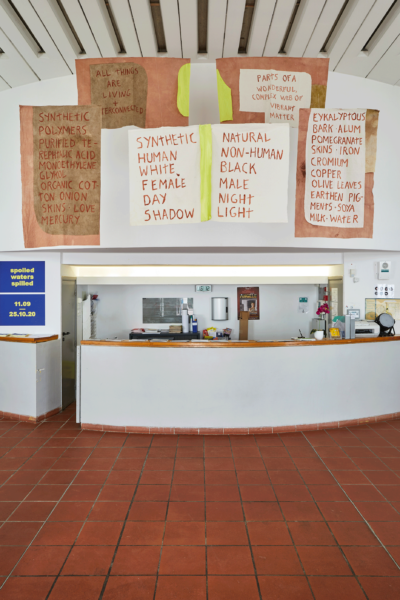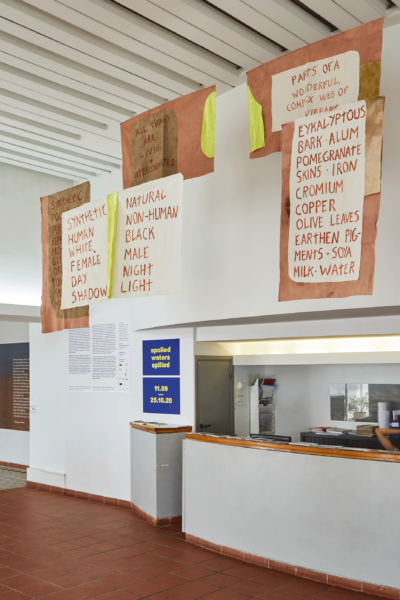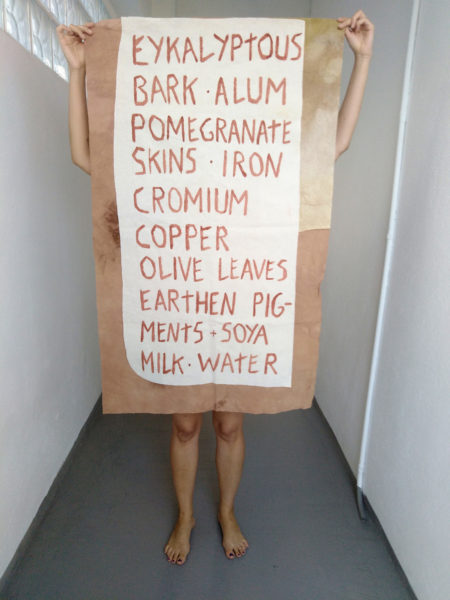Manifestation
The story that follows includes human as well as non-human protagonists. The first protagonist is a dress that exists in a trash-yard in the outskirts of Marseille; it is brightly coloured and made out of polyester. It’s been laying there at the bottom for years and years, while newer garments that land on top of it end up faster in the burning kiln. Luckily, it didn’t become C02 and ashes, but it doesn’t do anything anyway. Its process of decay is so painfully slow, it feels like eternity.
Our next character is a river in Indonesia. The water of this river ranges to a colourful palette, depending on its different spots. Apart from all this colour the river contains also 72 chemicals from the 214 textile factories along its banks. The dress and the river have once met. This Indonesian dress was imported in France in 2014. A human person bought it only 3 days after itstransition to the new land. And used it for about one year, before she threw it away. Plant-based dyes extracted from food leftovers, leaves, barks and flowers, cotton fibre woven into textile, tapwater, a stove, a pot, and a human being, the artist, gathered together to reflect on the matter. The literal matter, all of them: the synthetic polymers with their purified terephthalic acid (PTA) and the monoethylene glycol (MEG) both parts of polyester, all the complex combinationof mercury, lead, chromium, copper, sodium chloride, toluene, and benzene that compose the synthetic dyes and, of course, the river water and human labour materialised in sweat, blood, disease.
Complex matters deserve attention, not solutions. The members of the assembly faced each other as honestly as they could, trying to understand what does it mean to not make any more divisions between organic and inorganic, natural and synthetic, human and non-human. Their exchange eventually took the form of a structure that resembles a still of a manifestation, asking its spectators to pay more attention to the complex matter of anthropogenic processes of synthesising.
The work was presented in:
SPOILED WATERS SPILLED
artists: Minia Biabiany, Marjolijn Dijkman, Marianne Fahmy, Toril Johannessen, Valentina Karga, Jessika Khazrik for The Society of False Witnesses, Anouk Kruithof, Rikke Luther, Elvia Teotski
11.09 – 25.10.2020 / Ballet National de Marseille within Manifesta 13, Les Parallèles du Sud
Curated by: Clelia Coussonnet and Inga Lāce
Spoiled Waters Spilled is a project with an exhibition, a performance and discussions focused on the notion of toxicity, of circulation, of water (particularly rivers), on ecology and activism. Inspired by the organic circulation within the Mediterranean, the exhibition focuses on flowing substances such as water and air, that cross states’ borders while being poisoned on a local scale by human activity. Through poetry, video, installation and performance, it examines how industrial, agricultural and domestic pollutants disrupt the ‘postcard image’ of cities, degrading rivers, soils, sediments, surface and deep waters, impacting multiple living bodies. Spoiled Waters Spilled also aims at exploring the growing tension between the need for transnational responses to climate change and how nations enforce tougher border policies, often excluding all kind of ‘others’ and externalising the ecological issues.
-

Valentina Karga, Manifestation, 2020. in: Spoiled Waters Spilled, Manifesta 13 Parallèles du Sud,Courtesy of the artist ©Jeanchristophe Lett
-

Valentina Karga, Manifestation, 2020. in: Spoiled Waters Spilled, Manifesta 13 Parallèles du Sud,Courtesy of the artist ©Jeanchristophe Lett
-

Valentina Karga, Manifestation, 2020. in: Spoiled Waters Spilled, Manifesta 13 Parallèles du Sud,Courtesy of the artist ©Jeanchristophe Lett